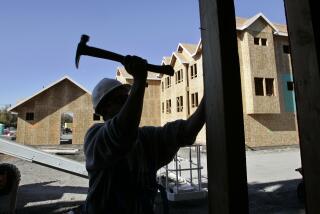Manufacturing Activity Back on Track
- Share via
TEMPE, Ariz. — The manufacturing sector of the economy resumed its growth in July, the first month it has expanded since April, the National Assn. of Purchasing Management said Tuesday.
The group said its monthly index of manufacturing activity rose to 50.5 in July from to 45.7 in June. A reading below 50 suggests a slowing manufacturing sector, while one above 50 signals growth.
“After two months of decline, production and new orders increased and order backlogs, inventories and employment decreased at a slower rate,” said Ralph Kauffman, chairman of the group’s Business Survey Committee and a purchasing manager at Oryx Energy Co.
Josh Feinman, vice president and global markets economist at BT Securities, said, “The NAPM was much stronger than expected, providing more confirmation of a bottoming in the manufacturing sector and signs of a turnaround.”
“It was not strong, but it was a noticeable uptick from the May and June numbers,” he said. The index was at 45.7 in June and 46.1 in May.
Economists noted that new orders recorded in the July index were particularly strong.
On the other hand, the time it took for suppliers to deliver goods in July shortened a bit, suggesting a little less demand for manufactured goods.
“Purchasing executives indicated in July that many suppliers are catching up with demand after months of not being able to deliver on time,” Kauffman said.
The NAPM said the survey’s price component was at 58.3 last month, the lowest in a year and a half. It was the first time the component had fallen below 60 since January, 1994.
Commodities listed in short supply by purchasers included paper, shipping containers, some computer chips and iron castings.
In other economic news, the Commerce Department reported that construction spending rose 0.9% in June, the largest advance in nearly a year, despite a sixth straight monthly decline in residential building.
However, analysts said spending in the interest-sensitive residential sector, which represents nearly half of construction outlays, should rebound in the second half of 1995, with cheaper mortgage rates luring buyers back into the market.
Spending on residential, non-residential and government projects totaled $520.4 billion at a seasonally adjusted annual rate in June, the department said.
“We look for construction spending and, more specifically, spending on residential construction in the ensuing months to post a moderate bounce-back as lower interest rates act as a catalyst for growth in the housing sector,” said economists Elliott Platt and John Bailey of Donaldson, Lufkin & Jenrette Securities Corp.
The 0.9% gain was the largest since a 1.6% advance in September, 1994. It recouped much of the 1.5% loss in May, the biggest since May, 1991, which also saw a 1.5% decline. The June figure was also 2.9% above that of June, 1994.
Non-residential outlays jumped 3.5% to $110.1 billion, including advances of 13% for hotels and motels and 10.2% for other commercial projects such as shopping centers. Public construction rose 1.1% to $140.6 billion, which includes a 4.6% increase in spending for highways and streets and a 2.5% increase in outlays for sewer systems.
More to Read
Inside the business of entertainment
The Wide Shot brings you news, analysis and insights on everything from streaming wars to production — and what it all means for the future.
You may occasionally receive promotional content from the Los Angeles Times.










